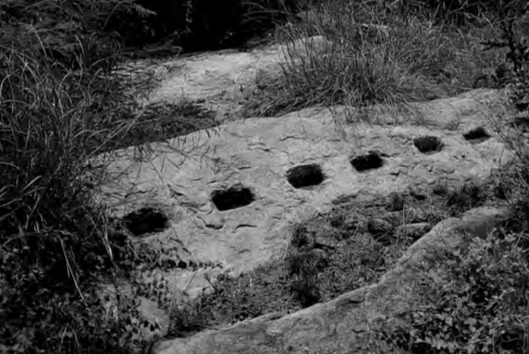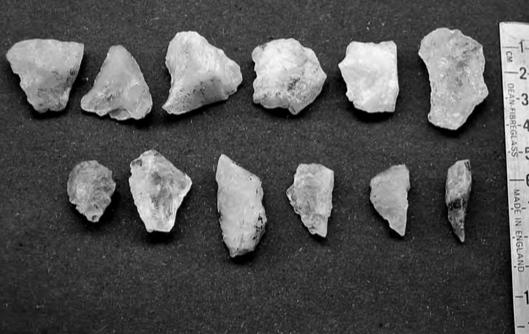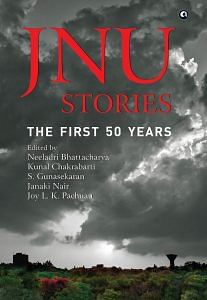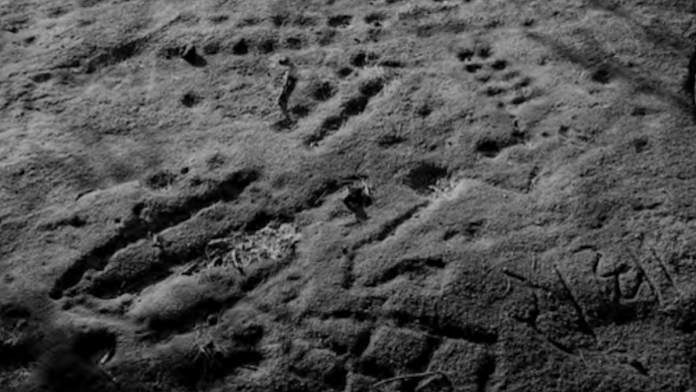The Delhi ridge, amidst which the JNU campus is located, has long been described as ‘lean but wiry fingers’, as ancient rocks sinking into the geologically younger alluviums of the Yamuna River. This romantic juxtaposition of the old and the new—an allegory for the nation and its capital—does little justice to the archaeological landscape of the campus. The JNU campus is a perfect microcosm, containing within its approximately 400 hectares much of the archaeological pasts of the Delhi region, ranging from the prehistoric to the recent. The fact that the large area enclosed within its walls remains relatively untouched by the infrastructural and construction processes that have transformed all else around—allows one to think not of archaeological sites, but rather of landscapes.
On this landscape, the distinctive grey rock of the JNU hills is a quartzite with a specific history of its own. Its origin from deeply weathered parent sandstones means that it is at once a typical metamorphic product of the Delhi Aravalli group of rocks, but also distinctively marked by a pyrite (FeS2) impurity. Over geological time, rainwater and the iron within interact to create a series of distinctive forms—most commonly, a series of rinds that accrue around the grey rock as layers of increasingly red and friable, sandlike weathering products. Fresh breaks on the rocks, as seen along the campus roads, redirect these processes and lead to a dirty, ferrous-red bleeding trail. In other places, the iron impurity has leached out and precipitated as thin black ‘crusts’. Excavation to bedrock on campus usually ends in metre-thick layers of decomposing quartzite in the form of red, sandy regolith. Most memorably for lives on campus, these processes lead to large rounded ‘tor’ formations, or the boulders that cap the ridges, best seen at ‘PSR’ or Parthasarathi Rocks. In addition, the JNU hills are marked by the intrusive veins of a milky transparent and white quartz as well as a micaceous pegmatite.
In the 1990s, a scholar at the School of Environmental Sciences noted that the campus hills were marked by thin sediment deposits that appeared like grassy vegetation mats, and decided to take a closer look at their origin. Using facilities and labs at the school, J. K. Tripathi (now faculty at SES) established that these sediments were neither the weathering products of the local hill quartzites nor were they related to the Yamuna alluviums. Instead, he explained, the campus was mantled, almost blanketed by airborne sediment from the Thar Desert. This had also occurred previously when the desert was larger and its processes of entrainment and redeposition of sand were far more intense than today.
Crossing from the western hostels to the academic block, entering into the valley, one traverses recently gullied, reworked Thar-derived sediments and crosses one of the streams that drain the hills. On either side of the valley floor, paths climb onto hillsides where very old rock surfaces wear thin patinas of long duree weathering processes where they remain unburied by fine sands and the grass they support. After every rain the grey rock, the red detritus, and the yellow sands commingle, and walking the JNU landscape means encountering an interweaved set of traces of different epochs all at once and subtly modified by each other.
For instance, to level the area for the statue of Jawaharlal Nehru at the Administration Block, a number of tors were cleared mechanically, one of which was covered with a range of old cupules. Sets of such features, usually found as dual rows of small holes pecked into the eroding rinds of the quartzite preserve one of the most widespread kinds of archaeological traces on campus. Some sets of these dots are more complex, occasionally intersecting with sets of two or four rows and are usually on large flat rocks. While such finds of petroglyphs have attracted symbolic interpretation elsewhere, on campus they helpfully occur alongside a range of other motifs: graffiti in Nagari (names), animals, stars, and a range of other expediently and informally chiselled-in forms.

Photo courtesy: Mudit Trivedi | Aleph
Before its acquisition by the government as institutional land, the campus was a part of the pastoral landscapes of Munirka and other villages and, thus, these cupules and art forms are the game boards and material ruminations of those who watched over their ruminants. Occasional footing courses of walls survive and suggest ridge-top casual structures and cattle pens. Close to these, on flat boulders, often are the cupule game boards—usually variations of pacchisi (ludo). Together, these traces suggest ways in which within the usually solitary exercise of grazing goats or cattle, a game and a meeting point were devised.
Ceramics are the most common archaeological finds and yet on the JNU campus they are almost entirely absent. What the archaeological survey did find was that when they are found, and when they can be identified, they are usually distinct kinds of medieval and early medieval lamp forms. It is tempting to think of these as related to the closest site of Lalkot, its walls barely a kilometre to the east of campus. While no distinct paths or routes survive archaeologically, to walk from Lalkot towards the Tughlaq-era madrasa, tombs and gardens at Muradabad Pahari or to head towards Munirka and further north-west, travellers would likely have passed through the campus area. One can almost envision these hills sitting quietly on the fringes of the city in its medieval past. At the very southern end of the campus, within the yawning, deep valley, there exist remains of what appears to be a small medieval quarry, exploiting the natural propensity of the exposed outcrop to foliate into rock sizes useful for medieval masonry. Elsewhere on campus we find the tell-tale wedge-and-split marks of similar medieval efforts to quarry and split boulders. Beyond this, while the Delhi region is dense in diverse evidence and sites for the early medieval, early historic and prehistoric/ Iron Age, and even Late Harappan periods—no such evidence is found within the walls.
What the campus does yield, however, are rich and complex finds that relate to the deeper pasts of the Delhi region. Several of the ridges on campus were found to bear the traces of microlith stone tool production. Microlith scatters, or remains of the waste stone left in reducing a nodule to a final tool, are distributed widely across the campus. They represent a time when people who knew the hills and its rocks very well ranged across it widely. These tools are fashioned on the distinctive quartz sourced from the rare but regular veins in the hills. They also used an exotic, tuffaceous sandstone, which is not known geologically on campus, but is well known, in the Delhi region. Together, the microlith scatters appear to tell an ill-understood story that is one of repeated expedient tool production by communities who knew the landscape and its lithic resources well. Their residues are found across every ridge, at both locations that afford commanding views over the landscape and are a sign of how they lived and used the land.
Their largest footprint on campus is at a location outside of Paschimabad where the stream exits the hillside and fans out in the valley. While we do not know exactly when these persons lived, we do know that they created the kinds of tools (scrapers and backed blades) that are usually involved in the processing of a range of materials like plants, hides, etc. Based on the present evidence, the microlith scatters suggest the picture of a community that knew its landscape well and likely ranged far and traded with other communities in the Delhi region.

Photo courtesy: Mudit Trivedi | Aleph
Also read: The Delhi prof who said tombs & mosques were not just ‘Muslim’, but ‘Indian Muslim’
Older still are arresting and exceptionally regular finds of much older tools, part of a tradition of stone tools that are amongst the oldest hominin occupations in South Asia. These date prior to at least 100,000 years ago, and are very likely two to three times that age. A diverse range of acheulian tools, hand-axes, cleavers, side-scrapers, end-scrapers, cores, and considerable numbers of what appear to be waste reduction flakes (byproducts of the process of making these tools), have been found. Notably, the JNU landscape comprises a range of sediments and rocks of different ages that persist on the surface, sometimes buried and re-exposed, in other cases never fully buried even over such timescales. This has meant that such old traces of the pre-modern human past also are regularly stumbled upon.
The present School of Physical Sciences sits upon one of the many ‘sites’ from the Palaeolithic age on the campus, and its foundation excavations yielded a buried acheulian floor, where half-finished tools, waste flakes, and large cores were recovered.
 This excerpt from ‘Landscape Stories: The Archaeological Pasts and Presents of the JNU Campus’ by Mudit Trivedi in the book ‘JNU Stories: The First 50 Years’ has been published with permission from Aleph Book Company.
This excerpt from ‘Landscape Stories: The Archaeological Pasts and Presents of the JNU Campus’ by Mudit Trivedi in the book ‘JNU Stories: The First 50 Years’ has been published with permission from Aleph Book Company.




All the more reason to shift the JNU campus to Samastipur, Bihar or 24 Parganas, West Bengal. They’re occupying a lot of space in prime location of Delhi. Convert JNU into an engineering school – Dr. APJ Kalam Institute of Technology Or Ramanujam Institute of Theoretical Computer Science.